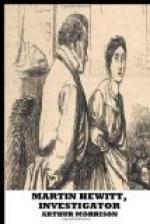“Yes, yes—I see; but you say you began with the knowledge that I broke into the place myself. How did you know that? I can not imagine a trace——”
“My dear sir, you left traces everywhere. In the first place, it struck me as curious, before I came here, that you had sent off that check for five thousand pounds to Lord Stanway an hour or so after the robbery was discovered; it looked so much as though you were sure of the cameo never coming back, and were in a hurry to avert suspicion. Of course I understood that, so far as I then knew the case, you were the most unlikely person in the world, and that your eagerness to repay Lord Stanway might be the most creditable thing possible. But the point was worth remembering, and I remembered it.
“When I came here, I saw suspicious indications in many directions, but the conclusive piece of evidence was that old hat hanging below the trap-door.”
“But I never touched it; I assure you, Mr. Hewitt, I never touched the hat; haven’t touched it for months——”
“Of course. If you had touched it, I might never have got the clue. But we’ll deal with the hat presently; that wasn’t what struck me at first. The trap-door first took my attention. Consider, now: Here was a trap-door, most insecurely hung on external hinges; the burglar had a screwdriver, for he took off the door-lock below with it. Why, then, didn’t he take this trap off by the hinges, instead of making a noise and taking longer time and trouble to burst the bolt from its fastenings? And why, if he were a stranger, was he able to plant his jimmy from the outside just exactly opposite the interior bolt? There was only one mark on the frame, and that precisely in the proper place.
“After that I saw the leather case. It had not been thrown away, or some corner would have shown signs of the fall. It had been put down carefully where it was found. These things, however, were of small importance compared with the hat. The hat, as you know, was exceedingly thick with dust—the accumulation of months. But, on the top side, presented toward the trap-door, were a score or so of raindrop marks. That was all. They were new marks, for there was no dust over them; they had merely had time to dry and cake the dust they had fallen on. Now, there had been no rain since




